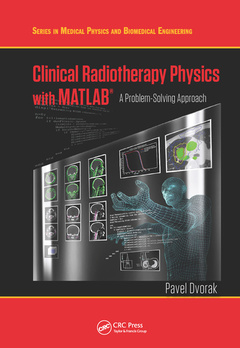Description
Clinical Radiotherapy Physics with MATLAB
A Problem-Solving Approach
Series in Medical Physics and Biomedical Engineering Series
Author: Dvorak Pavel
Language: English
Subjects for Clinical Radiotherapy Physics with MATLAB:
Keywords
Web Supplement; Dose Distribution; DICOM data; DVH; Phantom image; CT Model; 3D dose calculation; DICOM File; Three dimensional dose calculation; Dose Profile; Dose Bins; Film dosimetry; Comparing Dose Distributions; CT Series; Rt Structure; Inbuilt Function; In-built Function; Image Series; Data Sets; Vivo Dosimetry; Voxel Phantom; DICOM Rt; Gamma Calculation; Dose Calculation; MATLAB Command Window; Collimator Rotation; Dose Difference; Dose Calculation Algorithm; Reference Dose
Publication date: 06-2020
· 17.8x25.4 cm · Paperback
Publication date: 06-2018
· 17.8x25.4 cm · Hardback
Description
/li>Contents
/li>Readership
/li>Biography
/li>
The first MATLAB® programming book written specifically for clinical radiotherapy medical physicists and medical physics trainees, this much-needed book teaches users how to create their own clinical applications using MATLAB®, as a complement to commercial software particularly when the latter does not cover specific local clinical needs.
Chapters explore key radiotherapy areas such as handling volumes, 3D dose calculation, comparing dose distributions, reconstructing treatment plans and their summations, and automated tests for machine quality assurance. Readers will learn to independently analyse and process images, doses, structures, and other radiotherapy clinical data to deal with standard and non-standard situations in radiotherapy. This book will also significantly improve understanding of areas such as data nature, information content, DICOM RT standard, and data flow. It will be an invaluable reference for students of medical physics, in addition to clinical radiotherapy physicists and researchers working in radiotherapy.
Features:
- Includes real clinical medical physics applications derived from actual clinical problems
- Provides commented MATLAB® scripts working with sample data and/or own data matching input requirements
- Promotes critical thinking and practical problem solving skills
1. MATLAB essentials and principles of simple programming. 2. Radiotherapy physics related data types & basic operations. 3. Reconstructing basic DICOM RT data 4. Modifying DICOM data in radiotherapy. 5. Simple 3D plan sum using rigid registration. 6. Handling regions and volumes of interest in radiotherapy. 7. Three-dimensional dose calculation in radiotherapy. 8. Semi-automated measurement of linac major mechanical parameters. 9. Comparing dose distributions: the gamma method. 10. Example of accessory modeling in radiotherapy
Pavel Dvorak is a medical physicist with several years’ experience in managerial clinical positions. Within medical physics, he has worked in education, research, and clinical practice in public and private health institutions in the Czech Republic, Austria, and the United Kingdom. His speciality is implementing novel techniques and technologies, creating and managing efficient workflows, and problem solving in radiotherapy.




